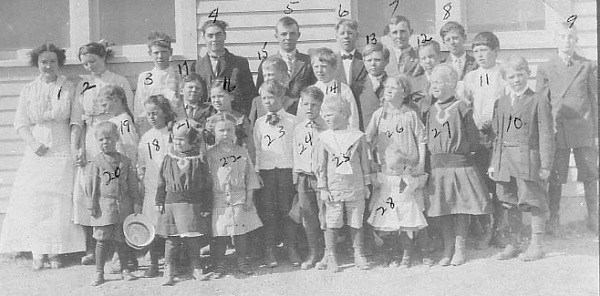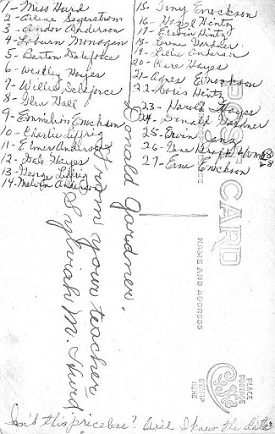
There were 25 one-room schools around South Prairie, but they were not open
all at the same time. They operated for sixty years and educated three
generations of children. These rural schools were a distinct success. For most
of their tenure they provided the only education their pupils were to get, as
going off to high school did not become general until the 1940's.
They
were community centers. They made life better in each neighborhood. As one
pioneer woman said, "we looked forward to the opening of school. It was all we
had." Another one said, "We had many good times in that little building."
Those that were still operating in 1960 had come a long way from the first
schools started in homesteaders' shacks. They had become modernized in both
facilities and methods. Their graduates were doing well wherever they went.
A succession of dedicated teachers labored through the years, some of them
were home-grown products, many came from other places. Some of them stayed to
settle down. They were seldom well-paid, but always hard-working and they made
their mark.
Extracted by Don Gardner from People of the Prairie
 1. Miss Sylviah M. Hurd (Teacher)
1. Miss Sylviah M. Hurd (Teacher)
2. Arlene Segerstrom
3. Ander Anderson
4. Loburn Monogan
5. Barton Deleforce
6. Westley Hayes
7. Willie Deleforce
8. Glen Hall
9. Emmilion Enockson
10. Charlie Liffrig
11. Elmer Anderson
12. Dale Hayes
13. George Liffrig
 14. Melvin Anderson
14. Melvin Anderson
15. Tony Enockson
16. Hazel Hintz
17. Erevin Hintz
18. Lorene Gardner
19. Lillie Anderson
20. Clare Hayes
21. Agnes Enockson
22. Doris Hintz
23. Harold Hayes
24. Donald Gardner
25. Ervin Janz
26. Gene Kraft
27. Erna Enockson
28. William Kraft
Ward county up to 1908 was the largest county in the state, largest in point of
population and extent of miles and was known as the "Imperial" county of Ward.
In 1908 Mountrail county was stricken off, and later two other new counties,
namely, Burke and Renville, were created.
The first settlers who came to
the region now known as Ward county in the early eighties were Elmer Francis,
who is still a resident of this region, William H. Wilson, and later, Dick
Copeland, who is now publishing a paper at Havre, Montana. James Johnson came
here in 1884, and located at Burlington, which was the first county seat. There
was quite an influx of settlers from 1881 to 1886. In the fall of 1886, the
Great Northern railroad, then known as the Manitoba, reached Minot from Devils
Lake.
In the summer of 1886, Olaf Olson, Ole Spokle, Ed. Kettleson, and
Erick Ramstad located in the immediate vicinity of Minot. Erick Ramstad filed on
a tract of land which is now on the north side of Minot, and brick's mother
filed on a tract which now includes the business district and a portion of the
residence district on the south side of Minot.
The year 1887 saw busy
times for the village of Minot. The town was incorporated in the spring of 1887
and James H. Schofield, who is still one of the substantial business men of
Minot, was elected the first mayor. At that time, Minot had about four hundred
inhabitants. In 1890, thirteen years later, Minot had one thousand two hundred
and seventy people and the Federal census .for 1910 shows Minot and North Minot,
which, during the year 1911, has been incorporated as a part of Minot, to have a
population of six thousand seven hundred twenty.
Minot is situated in the
heart of the Mouse River Loop, and is located at the intersection of two great
competing transcontinental lines of railway, the Great Northern and the Soo. It
is located on the Mouse river, one of the historic streams of the state, and its
future is assured.
Outside of the Red River Valley counties, Ward County
has less waste land than almost any county in the state. It is estimated that
ninety-eight per cent of the county is arable. Because of the abundance of free
land and cheap land east of Ward county, arid also because of the financial and
industrial depression which spread over the United States between 1893 and 1897,
Ward county was sparsely settled until about 1898, when an influx of settlers
took place; but between 1898 and 1905 the population of Ward county increased
from approximately four thousand five hundred people to forty thousand people,
while the census for 1910 shows the territory embraced in Ward county up to 1908
to have a population of fifty-nine thousand. Perhaps no region in the United
States, outside of the mining and oil regions, has grown so rapidly or has
developed so substantially and permanently as Ward county from 1898 to 1906,
which year practically saw the last of the free land within the county.
In ability to produce all the crops known to this region Ward County has been
the peer of any county in the state. Our production of wheat, flax, and other
cereals has been enormous. In twelve years land has gone from no price to fifty
dollars an acre, and perhaps the average of improved land in all that part of
the county east of the Choteau's would average in price above $35.00 per acre,
and it is cheap, exceedingly cheap at this price, as our lands will produce as
many dollars per acre and perhaps on the average more, certainly more with the
same workmanship and labor expended, than the high priced land of Iowa and
Illinois.
The increase in the acreage of corn in Ward County for the year
1911 is estimated at five hundred per cent. The statistics, as will be, later
shown by the assessor's report, are not yet available, but the per cent given is
estimated to be conservative. The assessed valuation of Ward County is in the
neighborhood of fourteen millions of dollars; which is one of the largest in the
state.
Ward County is peopled by a lot of hardy yeomanry, the great bulk
of our population coming from the middle western states, such as Minnesota,
Wisconsin, Iowa, Indiana and Illinois. Perhaps more than forty per cent of the
people of Ward County are of Scandinavian origin, than which no people are more
successful pioneers.
Ward County has produced as high as sixteen bushels
of flax per acre on an average, and is recognized as the greatest flax growing
county in the state.
The acreage in corn has increased 35 per cent and
the number of hogs and milk cows to the same extent during the past two years.
Ward County has three hundred eighty-five miles of railroad, 365 schools,
thirty-six state and national banks, and sixty-one post offices. It has two and
one-half head of cattle on an average to every, man, woman and child in the
county, making it one of the good stock counties of the state. The United States
Geological Survey figures that Ward county has more tons of coal underlying its
surface than has any other county in the state, and North Dakota has more tons
of coal underlying its surface than has any other state in the Union. The
average altitude of Ward County is one thousand five hundred eighty feet, which
is supposed to be nearly ideal for all grain crops.
At Minot there is
established and running a lignite coal briquette plant. Erected at a cost of
$150,000, this plant has a capacity of 100 tons per day. The quality of these
briquettes in heating power equals that of anthracite coal. It is, the opinion
of thoughtful, conservative business men that the establishing of this
institution marks a new era in the use of lignite coal. It is believed and fully
expected that, at an early period, one of the byproducts -- gas -- will heat the
homes and furnish electricity not only for the city of Minot, but for other
towns and cities at distant points. It means cheap power and cheap power means
manufacturing industries.
Minot, the metropolis not only of Ward County,
but of all the western part of the state, is one of the greatest distributing
points for farm machinery in the world. Minot is growing steadily and for the
year 1911 the buildings erected approximated a million dollars in value. The
banks in the city of Minot have deposits of nearly two millions of dollars. It
has one of the three first class post offices of the state, its postal receipts
exceeding forty two thousand dollars yearly. It has a large number of wholesale
houses tend two of the largest wholesale grocery houses in the state. Its retail
merchants are prosperous; its schools are flourishing, and its citizens are
leading happy, contented lives, and all pulling together to make Minot the
largest city in the commonwealth of North Dakota.
At Minot is also
located one of the state's normal schools, erected at a cost of $240,000.00. The
buildings are made of reinforced concrete, with Hebron pressed brick finish. In
point of design, convenience of arrangement, and durability of structure, they
are the latest best thought in modern educational architecture. The large number
of students in attendance at this school for the opening year is ample evidence
that in the course of a very few years, this school will be one of the state's
largest and strongest educational institutions.
Other towns in the county
enjoying a rapid growth and taking a leading part in the development of their
respective tributary territories are Kenmare, with a population according to the
last census of nearly 1,500, Sawyer, Carpio and Donnybrook on the "Soo," and
Surrey, Des Lacs, Berthold, Kenaston on the Great Northern.
Notwithstanding the separation from her of the counties of Burke, Renville and
Mountrail, Ward county does not seem to have suffered materially in her
agricultural output, which for 1912 was as follows: Spring wheat, 2,213,430
bushels; durum wheat, 21,495 bushels; flax, 230,528 bushels; oats, 1,427,561
bushels; barley, 204,09 bushels; winter rye, 19,725 bushels; speltz, 21,258
bushels; corn, 13,656 acres; potatoes, 185,767 bushels.
Contributor and
Source: Unknown
Ward County NDGenWeb Copyright
Design by
Templates in Time
This page was last updated
01/22/2022